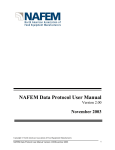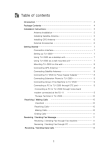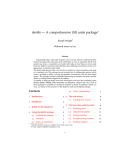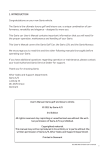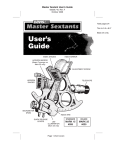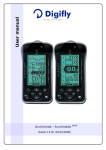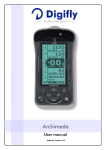Download latest PDF - Read the Docs
Transcript
ETS Documentation Release 4.1.3.dev0 Enthought November 05, 2015 Contents 1 SciMath Units Documentation 1.1 Scimath Units User Manual Copyright Notice . 1.2 Introduction to SciMath Units . . . . . . . . . 1.3 Units with Numpy . . . . . . . . . . . . . . . 1.4 Unitted Functions . . . . . . . . . . . . . . . 1.5 Extending the Unit Parser . . . . . . . . . . . 1.6 Types of Units Available . . . . . . . . . . . . 1.7 Scimath Units User Reference . . . . . . . . . . . . . . . . . . . . . . . . . . . . . . . . . . . . . . . . . . . . . . . . . . . . . . . . . . . . . . . . . . . . . . . . . . . . . . . . . . . . . . . . . . . . . . . . . . . . . . . . . . . . . . . . . . . . . . . . . . . . . . . . . . . . . . . . . . . . . . . . . . . . . . . . . . . . . . . . . . . . . . . . . . . . . . . . . . . . . . . . . . . . . . . . . . . . . . . . . . . . . . . . . . . . 3 3 4 5 6 7 8 10 2 SciMath Interpolate Documentation 13 3 SciMath Mathematics Documentation 15 4 Indices and tables 17 i ii ETS Documentation, Release 4.1.3.dev0 The SciMath project includes packages to support scientific and mathematical calculations. Contents: Contents 1 ETS Documentation, Release 4.1.3.dev0 2 Contents CHAPTER 1 SciMath Units Documentation Contents: 1.1 Scimath Units User Manual Copyright Notice Authors Tim Diller Version Document Version 1 Copyright 2011 Enthought, Inc. All Rights Reserved. Redistribution and use of this document in source and derived forms, with or without modification, are permitted provided that the following conditions are met: • Redistributions of source or derived format (for example, Portable Document Format or Hypertext Markup Language) must retain the above copyright notice, this list of conditions and the following disclaimer. • Neither the name of Enthought, Inc., nor the names of contributors may be used to endorse or promote products derived from this document without specific prior written permission. THIS DOCUMENT IS PROVIDED BY THE COPYRIGHT HOLDERS AND CONTRIBUTORS “AS IS” AND ANY EXPRESS OR IMPLIED WARRANTIES, INCLUDING, BUT NOT LIMITED TO, THE IMPLIED WARRANTIES OF MERCHANTABILITY AND FITNESS FOR A PARTICULAR PURPOSE ARE DISCLAIMED. IN NO EVENT SHALL THE COPYRIGHT HOLDERS OR CONTRIBUTORS BE LIABLE FOR ANY DIRECT, INDIRECT, INCIDENTAL, SPECIAL, EXEMPLARY, OR CONSEQUENTIAL DAMAGES (INCLUDING, BUT NOT LIMITED TO, PROCUREMENT OF SUBSTITUTE GOODS OR SERVICES; LOSS OF USE, DATA, OR PROFITS; OR BUSINESS INTERRUPTION) HOWEVER CAUSED AND ON ANY THEORY OF LIABILITY, WHETHER IN CONTRACT, STRICT LIABILITY, OR TORT (INCLUDING NEGLIGENCE OR OTHERWISE) ARISING IN ANY WAY OUT OF THE USE OF THIS DOCUMENT, EVEN IF ADVISED OF THE POSSIBILITY OF SUCH DAMAGE. All trademarks and registered trademarks are the property of their respective owners. Enthought, Inc. 515 Congress Avenue Suite 2100 Austin TX 78701 1.512.536.1057 (voice) 1.512.536.1059 (fax) http://www.enthought.com 3 ETS Documentation, Release 4.1.3.dev0 [email protected] 1.2 Introduction to SciMath Units A large number of units used in science and engineering are available for use, and scimath.units makes working with and converting among them easy. 1.2.1 Getting Started We can import unit objects from the scimath.units submodules. (See list of available units for a listing by submodule.) There are submodules for many categories of physical quantities. >>> from scimath.units.length import foot, inch, meter >>> 3 * foot 0.9144000000000001*m >>> foot / inch 12.0 >>> foot / meter 0.3048 Unit objects display natively in SI fundamental units and can be used to generate unit conversion factors or to see how units relate to one another. >>> from scimath.units.pressure import pascal >>> pascal * meter ** 2 1.0*m*kg*s**-2 Caution: If you are using this tool to produce conversion factors, remember that the factor is the inverse of what it looks like. Above, we divided one foot by one meter to get the ratio 0.3048. That is, foot / meter yields the number of meters per foot. Be careful to think through the logic clearly when developing conversion factors. You can define your own arbitrary units and use them for calculating conversion factors: >>> from scimath.units.length import inch >>> from scimath.units.force import lbf >>> from scimath.units.pressure import torr >>> my_psi = 2 * lbf / inch ** 2 >>> my_psi / torr 103.44718363855331 Internally, they are stored as a derivation of fundamental physical quantities expressed in the SI system >>> my_psi 13789.509579019157*m**-1*kg*s**-2 Conversions can be made between units with the same derivation using convert(): >>> from scimath.units.api import convert >>> from scimath.units.force import lbf, newton >>> convert(1, lbf, newton) 4.44822 However, adding incompatible units raises an IncompatibleUnits exception: >>> from scimath.units.electromagnetism import volt >>> from scimath.units.mass import kilogram >>> 1 * volt + 2 * kilogram 4 Chapter 1. SciMath Units Documentation ETS Documentation, Release 4.1.3.dev0 Traceback (most recent call last): File "<stdin>", line 1, in <module> File "scimath/units/unit.py", line 62, in __add__ raise IncompatibleUnits("add", self, other) scimath.units.unit.IncompatibleUnits: Cannot add quanitites with units of 'm**2*kg*s**-3*A**-1' and ' 1.3 Units with Numpy For high-performance computation, Scimath.units includes two objects for adding units to Numpy ndarray objects: the UnitScalar and the UnitArray. UnitScalars and UnitArrays can be used directly in computations but are best handled with unitted functions constructed using the has_units() decorator. 1.3.1 Working with UnitScalars and UnitArrays UnitScalar example As a basic example using scalar values, let’s create two UnitScalars and add them. Say we were averaging the wing spans of African swallows (a) with that of European swallows (e). >>> from scimath.units.api import UnitScalar >>> a = UnitScalar(5, units="inches") >>> e = UnitScalar(15, units="cm") >>> (a + e) / 2 UnitScalar(5.452755905511811, units='0.025400000000000002*m') Note that the result is a UnitScalar whose default units are inches, but it displays as a derivation from the SI fundamental unit meters. This is because UnitScalar values are stored internally as derivations of the SI system, thus if the value is assigned in a non-SI unit, part of the value may appear in the units. (See the section on internal representation for more detail.) >>> UnitScalar(1, units="inch") UnitScalar(1, units='0.025400000000000002*m') A UnitScalar assumes the units that are first assigned to it. From the example above, >>> (e + a) / 2 UnitScalar(13.85, units='0.01*m') This does not fundamentally change the value of the variable, but it can lead to rounding errors and unexpected results: >>> (e + a) == (a + e) UnitScalar(False, units='None') since >>> (a + e) - (e + a) UnitScalar(1.7763568394002505e-15, units='0.025400000000000002*m') which is awfully close but not quite equal to zero. UnitArray example A UnitArray uses a Numpy ndarray as its value. 1.3. Units with Numpy 5 ETS Documentation, Release 4.1.3.dev0 >>> from numpy import linspace >>> a = UnitArray(linspace(0, 5, 6), units="cm") >>> a UnitArray([ 0., 1., 2., 3., 4., 5.], units='0.01*m') UnitArrays can be multiplied by UnitScalars or other UnitArrays, as in NumPy.: >>> a * b UnitArray([0., 1., 2., 3., 4., 5.], units='0.0030480000000000004*m**2') Note that part of the value is contained in the unit string. For high-performance computation with UnitArrays use unitted functions. 1.4 Unitted Functions A function which handles UnitArrays and UnitScalars is a unitted function. Unitted functions are created with the has_units() decorator. The units can be specified by passing arguments to the decorator or by constructing a special docstring. 1.4.1 Decorator arguments from numpy import array from scimath.units.api import has_units from scimath.units.length import feet, meter @has_units(inputs="a:an array:units=ft;b:array:units=ft", outputs="result:an array:units=m") def add(a,b): """ Add two arrays in ft and convert them to m. """ return (a + b) * feet / meter To use has_units with decorator arguments, pass string arguments “inputs” and (optionally) “outputs”. See the has_units() docstring or visit the User Reference page for details on the syntax. 1.4.2 Formatted docstring from scimath.units.api import has_units, UnitArray @has_units def add(a,b): """ Add two arrays in ft and convert them to m. Parameters ---------a : array : units=ft An array b : array : units=ft Another array Returns ------c : array : units=m c = a + b 6 Chapter 1. SciMath Units Documentation ETS Documentation, Release 4.1.3.dev0 """ return (a + b) * feet / meter Using the has_units decorator with a docstring has the benefit of using a ReST-compatible format, so the unitting specification doubles as a documentation entry. See the has_units() docstring or visit the User Reference page for details on the syntax. The example above produces the following documentation entry when built with Sphinx: 1.4.3 Unitted function output In the examples above, we told add() to expect two values, a and b and convert them to feet for use in the function. Then we specified that the output would be in meters. Inside the function, a and b are not unitted, and the function is responsible for the conversion. (Remember our caveat regarding conversion factors.) Unitted functions can accept either regular Python objects (of the appropriate type) or the equivalent unitted objects. The return type depends on what it was passed. >>> add(1,2) 0.9144000000000001 In this case, add() accepted two integer arguments in feet, added them and returned an integer value in meters. >>> add(UnitScalar(1, units="foot"), UnitScalar(2, units="foot")) UnitScalar(0.9144000000000001, units='1.0*m') In this case, add() accepted two UnitScalar arguments in feet and returned a UnitScalar in pure meters. >>> add(UnitScalar(0.5, units="meter"), UnitScalar(50, units="cm")) UnitScalar(1.0, units='1.0*m') Finally, in this case, a conversion to feet was made for the calculation inside the function, and the value was converted back to meters when returned. If no units are specified in the outputs or if no output string is given, then a regular scalar data type will be returned. It may be useful to define new units for use in a project and have them available throughout an application. This is done by extending the unit parser to handle user-defined units, described in the next section. 1.5 Extending the Unit Parser If you define a series of units that you want to be available for import and use in unitted functions, then you must use the unit_parser as in the following file, imported later as scimath/units/example_units: from scimath.units.api import unit_parser from scimath.units.mass import kilogram apple = 0.2 * kilogram apple.label = 'label' bread = 0.5 * kilogram bread.label = 'loaf of bread' very_small_rocks = 0.02 * kilogram very_small_rocks.label = 'very small rocks' a_duck = 1.3 * kilogram a_duck.label = 'a duck' 1.5. Extending the Unit Parser 7 ETS Documentation, Release 4.1.3.dev0 import example_units as u unit_parser.parser.extend(u) When example_units is imported, unit_parser will be updated, and a unitted function can be built, as follows, from scimath/units/example.py: from scimath.units.api import has_units from scimath.units.example_units import a_duck @has_units def witch_test(mass_of_maiden): """ Test to determine if one or more young maidens is a witch. Parameters ---------mass_of_maiden : array : units=a_duck array of masses to check against the weight of a duck Returns ------truth : bool """ return mass_of_maiden >= 1 The behavior is as expected: >>> from scimath.units.example import witch_test >>> from scimath.units.mass import pound >>> from scimath.units.api import UnitArray >>> from numpy.random import randn >>> maidens = UnitArray(randn(5)*15 + 100, units="pound") >>> witch_test(maidens) array([ True, True, True, True, True], dtype=bool) 1.6 Types of Units Available In the following sections, the units available from each scimath.units sub-module are listed. For convenience units are sometimes imported into a module from the module where they were defined. 1.6.1 scimath.units.acceleration f_per_s2, feet_per_second_squared, ft_per_s2, m_per_s2, meters_per_second_squared 1.6.2 scimath.units.angle circle, circles, deg, degree, degrees, gon, gons, grad, grads, math, mil, mils, minute, minutes, quadrant, quadrants, radian, radians, revolution, revolutions, right_angle, right_angles, second, seconds, sextant, sextants, sign, signs, turn, turns 1.6.3 scimath.units.area acre, barn, hectare, square_centimeter, square_foot, square_inch, square_meter, square_mile 8 Chapter 1. SciMath Units Documentation ETS Documentation, Release 4.1.3.dev0 1.6.4 scimath.units.density g_per_c3, g_per_cc, g_per_cm3, gcc, gm_per_c3, gm_per_cc, gm_per_cm3, grams_per_cubic_centimeter, kg_per_m3, kilograms_per_cubic_meter, lb_per_gal, lb_per_gallon grams_per_cc, 1.6.5 scimath.units.dimensionless api, dimensionless, dim, fractional, fraction, gapi[#gamma_ray]_, one, parts_per_million, parts_per_one, pct, percent, percentage, ppm 1.6.6 scimath.units.electromagnetism amp, ampere, amps, amperes, coulomb, farad, henry, henrys, mho, micro_farad, mA, milli_ampere, milli_amp, millivolts, mmho, mSiemen, mS, mv, ohms, ohmm, ohm_m, ohm_meter, ohms_per_m, ohms_per_meter, pf, pico_farad, siemen, siemens_per_meter, siemens_per_m, tesla, teslas, uf, volts, v, weber, webers 1.6.7 scimath.units.energy Btu, Calorie, GeV, J, KeV, MJ, MeV, cal, calorie, eV, electron_volt, erg, foot_pound, horse_power_hour, joule, kJ, kcal, kilowatt_hour 1.6.8 scimath.units.force lbf, lbs, N, newton 1.6.9 scimath.units.frequency Hz, RPM, hertz, hz, khz, kilohertz, rpm 1.6.10 scimath.units.geo_units GPa, MPa, MPa_per_100f, MPa_per_100ft, MPa_per_f, MPa_per_ft, MPa_per_m, api 1 , apsi, becquerel, frac, fraction, fractional, g_ft_per_cc_s, g_km_per_cc_s, gapi 1 , gray, lb_per_gal, lb_per_gallon, parts_per_million, parts_per_one, pct, percent, percentage, ppg, ppm, psi_per_f, psi_per_ft, us_fluid_gallon, us_per_ft 1.6.11 scimath.units.length IN, angstrom, astronomical_unit, centimeter, centimeters, cm, f, fathom, feet, fermi, foot, ft, inch, inches, kilometer, kilometers, km, light_year, m, meter, meters, micrometer, micron, mile, millimeter, millimeters, mm, nanometer, nautical_mile, nm, parsec, um, yard 1.6.12 scimath.units.mass centigram, cg, g, gm, gram, grams, kg, kilogram, kilograms, lb, lbs, metric_ton, mg, milligram, ounce, pound, pounds, ton 1 American Petroleum Institute units for gamma radiation 1.6. Types of Units Available 9 ETS Documentation, Release 4.1.3.dev0 1.6.13 scimath.units.power horsepower, kilowatt, kw, watt 1.6.14 scimath.units.pressure GPa, MPa, Pa, apsi, atm, atmosphere, bar, kPa, kbar, kbars, kilobar, millibar, pascal, punds_per_square_inch, psi, psig, torr 1.6.15 scimath.units.SI ampere, atto, becquerel, candela, centi, copy, coulomb, deci, deka, dimensionless, exa, farad, femto, giga, gray, hecto, henry, hertz, joule, katal, kilo, kilogram, lumen, lux, mega, meter, micro, milli, mole, nano, newton, none, ohm, pascal, peta, pico, radian, second, siemens, sievert, steradian, tera, tesla, unit, volt, watt, weber, yocto, yotta, zepto, zetta 1.6.16 scimath.units.speed f_per_s, f_per_sec, feet_per_second, ft_per_s, ft_per_sec, kilometers_per_second, km_per_s, km_per_sec, knot, m_per_s, m_per_sec, meters_per_millisecond, meters_per_second, miles_per_hour 1.6.17 scimath.units.substance kmol, mol, mole 1.6.18 scimath.units.temperature K, celsius, degC, degF, degK, degc, degf, degk, fahrenheit, kelvin, rankine 1.6.19 scimath.units.time day, hour, micro, microsecond, microseconds, milli, millisecond, milliseconds, minute, ms, msec, nano, nanosecond, ns, pico, picosecond, ps, s, sec, second, seconds, us, usec, year 1.6.20 scimath.units.volume barrel, bbl, c3, cc, centimeter, cm3, cubic_centimeter, cubic_foot, cubic_inch, cubic_meter, cuft, f3, ft3, gallon, gallons, liter, liters, m3, us_fluid_gallon, us_fluid_ounce, us_fluid_quart, us_pint 1.7 Scimath Units User Reference 1.7.1 Internal Representation Internally, a scimath unit is a unit object: class unit(value, derivation) 10 Chapter 1. SciMath Units Documentation ETS Documentation, Release 4.1.3.dev0 value a scalar quantity which holds the magnitude of the unit, relative to the derivation in SI units. derivation a 7-tuple holding the power of each fundamental quantity in the unit: (length, mass, time, electrical current, temperature, amount of substance, luminous intensity). The labels of the fundamental quantities are given in the attribute _labels=(‘m’, ‘kg’, ‘s’, ‘A’, ‘K’, ‘mol’, ‘cd’) label the display name of the unit. For example, the predefined unit Newton has the following attributes: >>> from scimath.units.force import newton, lbf >>> newton.value 1.0 >>> newton.derivation (1, 1, -2, 0, 0, 0, 0) >>> newton.label 'newton' >>> lbf.value 4.44822 >>> lbf.derivation (1, 1, -2, 0, 0, 0, 0) 1.7.2 Limited API reference Convert HasUnits UnitScalar UnitArray 1.7. Scimath Units User Reference 11 ETS Documentation, Release 4.1.3.dev0 12 Chapter 1. SciMath Units Documentation CHAPTER 2 SciMath Interpolate Documentation Contents: 13 ETS Documentation, Release 4.1.3.dev0 14 Chapter 2. SciMath Interpolate Documentation CHAPTER 3 SciMath Mathematics Documentation Contents: 15 ETS Documentation, Release 4.1.3.dev0 16 Chapter 3. SciMath Mathematics Documentation CHAPTER 4 Indices and tables • genindex • modindex • search 17 ETS Documentation, Release 4.1.3.dev0 18 Chapter 4. Indices and tables Index D derivation (unit attribute), 11 L label (unit attribute), 11 U unit (built-in class), 10 V value (unit attribute), 10 19
























